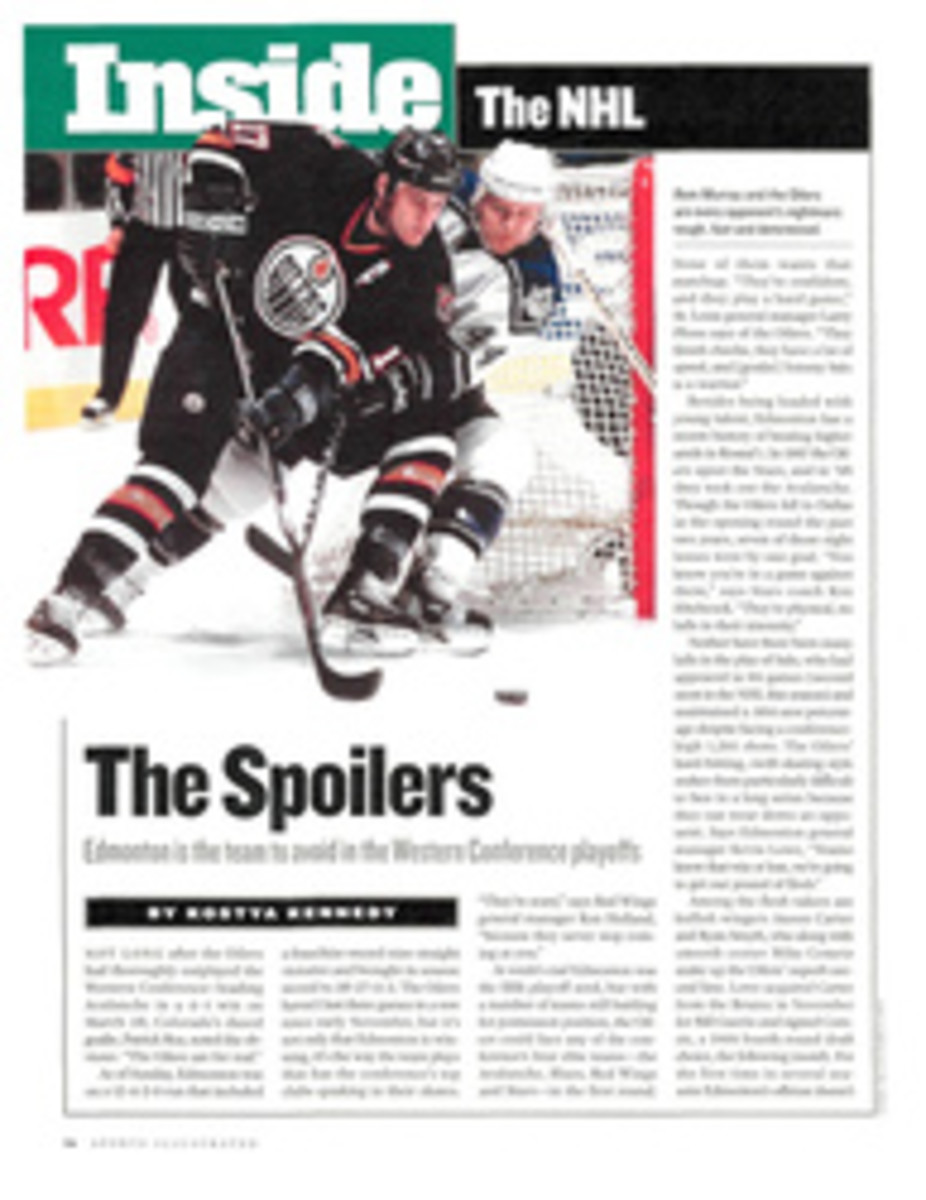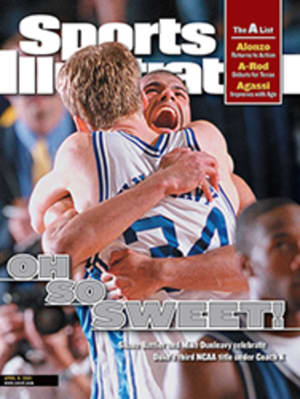
Notebook
Cross-handed Putting
Losing Its Grip
About this time last year, conventional wisdom held that use of
the cross-handed--or left-hand-low--putting grip was about to make
a quantum leap among tour pros. Vijay Singh went left hand low to
win the Masters. Karrie Webb switched to the grip, and so did her
chief rival, Annika Sorenstam. Lifelong cross-hander Jim Furyk
put on a great display of clutch putting to win at Doral, and the
playoff participants in Houston, Robert Allenby and Craig
Stadler, both used the grip. All this led putting guru Dave Pelz
to proclaim, "The question is not if the majority of pros will
putt left hand low, it's when."
That was then. This year, with the proliferation of the
45-inch-long belly button putters, which a player braces in his
midsection, and more esoteric grips, such as Mark Calcavecchia's
Claw, the cross-handed grip has lost its cachet. Singh has
switched to the belly button putter, and Furyk is experimenting
with it. Sorenstam abandoned the cross-handed grip during the
off-season and this year has grabbed the headlines from Webb with
a 59 and three straight victories.
Pelz remains a believer. "Left hand low is more instinctive," he
says. "If you take two groups of beginners and train one in the
left-hand-low method and the other in the conventional, the
left-hand-low group does better."
Pelz admits that left-hand-low putting is less in vogue this
year. "These things go in cycles," he says. "I still believe
you'll see more left hand low, only now we're in a cycle of
experimentation."
Noted instructor Jim McLean disagrees. The left-hand-low grip
reduces the influence of the power hand, or the right hand of a
right-handed player, and makes the stroke more of a pull than a
push. McLean says that the great putters--Isao Aoki, Seve
Ballesteros, Ben Crenshaw, Brad Faxon and Bobby Locke--had one
thing in common: "They relied on the feel and rhythm they got
from their right hands. Left hand low is fine for less gifted
players who need more consistency on short putts, but the artists
rely on their right hands, the way a painter does.
"There has never been a truly great putter who has putted
cross-handed. If left hand low were truly better, the best
players would have switched by now. At a place like Augusta,
where so much feel is involved, cross-handed doesn't work as
well."
Byron Nelson's Secrets
End of the Line
On Thursday 89-year-old Byron Nelson was to hit his last
ceremonial opening drive at the Masters, a task he has performed
for 20 years. Much will be written about Nelson and his legendary
career this week, but here are five things that may be missed.
1. Nelson celebrates the anniversary of his second marriage, to
Peggy, every month instead of every year because, he says,
"there's never enough time to tell her how much she means to me."
2. Nelson played in the British Open only twice (and just once
before retiring from the Tour in 1946) because he feared boats,
the preferred method of traveling from the U.S. to Britain at the
time. He says not attending was the lone regret of his career.
3. Nelson has had an accident in his woodworking shop in each of
the last two years, slicing off a portion of his left hand both
times. He also had a pacemaker inserted in 1999.
4. Nelson plays once a month at Riverhill Country Club in
Kerrville, Texas, to prepare for his one swing at the Masters.
(He fears he will top the ball off the 1st tee.)
5. After good friend and U.S. captain Ken Venturi invited him to
the Presidents Cup, Nelson was crushed last year when no one
followed up to make arrangements. --Art Stricklin
COLOR PHOTO: JOHN MILLER/AP Sorenstam came out smoking after going back to a conventional grip.
COLOR PHOTO: GREGORY M. FOTA
COLOR PHOTO: JOHN BARD
COLOR PHOTO: MICHAEL PRICE
Trust Me
For Phil Mickelson to beat Tiger Woods, he must cut down on his
unforced errors. Lefty's good shots are the equal of Tiger's,
but his bad shots are frequent and destructive. At Bay Hill, at
the Players Championship and at the BellSouth, Mickelson killed
himself with loose swings and sloppy three-putts. Woods is
confident that if he gets into a shootout with Mickelson, Lefty
will eventually make a fatal mistake.
Threesomes
What do these players have in common?
--Fred Couples
--Jack Nicklaus
--Tom Watson
They are the only players with a subpar scoring average in 50 or
more rounds at the Masters. Couples's average is 71.58 in 64
rounds, Nicklaus's 71.74 in 155 rounds and Watson's 71.67 in 98
rounds.
Feedback
Do you think Augusta National should lift its ban on CBS's Gary
McCord?
Yes 82%
No 18%
--Based on 5,260 responses to our informal survey
Next question: Should Arnold Palmer serve as an honorary starter
at the Masters?
Vote at golfplus.cnnsi.com.
Numbers
If Tiger Woods is to win more majors than Jack Nicklaus, he
would do well to load up on green jackets. Here are the 12
players who have won the most majors since 1934, the year the
Masters was first played, and the percentage of those majors
that were won in Augusta.
Masters Majors Pct.
Jack Nicklaus 6 18 33%
Gary Player 3 9 33%
Ben Hogan 2 9 22%
Tom Watson 2 8 25%
Sam Snead 3 7 43%
Arnold Palmer 4 6 67%
Nick Faldo 3 6 50%
Seve Ballesteros 2 5 40%
Byron Nelson 2 5 40%
Tiger Woods 1 5 20%
Lee Trevino 0 5 0%
Peter Thomson 0 5 0%
Faces
Terry Hatch, Pottsville, Pa.
Hatch, 32, the head pro at Mountain Valley Golf Course in St.
Clair, Pa., prevailed at the PGA Match Play to become the fourth
club pro to take the PGA Match and the Stroke Play titles in the
same year. Hatch, whose Stroke Play win came in January,
defeated David Young, the pro at Hudson National in Croton,
N.Y., one up in the final.
Steve Sokol, Oxford, Conn.
Sokol, a junior at Florida Southern, won the individual crown
and helped the Moccasins, the Division II national champions for
the last three years, successfully defend their team title at
the Matlock Collegiate in Lakeland, Fla. Sokol also set a school
record with a seven-under 64 in the third round at the Nelson
Invitational in Palo Alto, Calif.
Elizabeth Alger, Tequesta, Fla.
Elizabeth, 12, shot a 44-over 270 in three rounds to win her age
division by 50 strokes at the Kiawah Island Junior Championship.
A seventh-grader at Batt Private School in Juno Beach, Elizabeth
has been victorious in 14 of 18 starts in International Junior
Golf Tour and Florida Junior Golf Association tournaments.
Submit Faces candidates to golfplus.cnnsi.com/faces.

